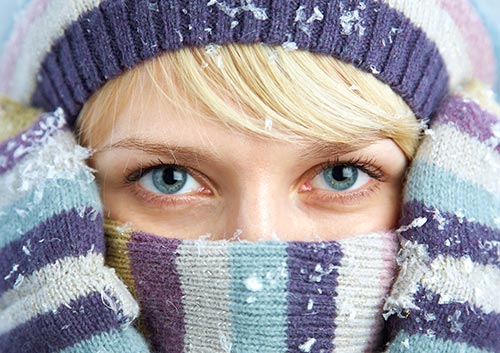Winter Is Here… And So Is Dry Eye!

Are your eyes feeling especially tired and dry during these winter months? Winter not only brings frigid temperatures and shorter days, it also brings low humidity outside and dry indoor heating which can exacerbate dry eye disease and symptoms. Millions of people in the U.S. suffer from dry eye disease and many are undiagnosed and unaware of all the treatment options. As doctors of optometry, our goals are to help those suffering from dry eye disease and provide the best treatment plan for their condition.
What is Dry Eye Disease?
Dry eye disease is a condition caused by chronic, inadequate lubrication of the ocular surface. Tears nourish the front surface of the eye to provide healthy eye function and clear vision. If the front surface does not have consistent and good quality tear coverage, it becomes irritated and causes uncomfortable symptoms.
What are the Symptoms?
The symptoms of dry eye disease vary depending on the severity of the condition and can include:
- Stinging or burning feeling
- Redness
- Gritty or itchy feeling
- Watery eyes
- Pain or discomfort
- Tired eyes worse at the end of the day
- Blurred vision
- Discomfort with long term reading or computer use
- Light sensitivity
Who is at Risk for Dry Eye Disease?
Dry eye disease is more common in women and can develop with aging. Other risk factors include:
- contact lens wear
- medications
- extended computer use
- medical conditions like diabetes, Sjogren’s syndrome, rheumatoid arthritis, lupus, vitamin A deficiency, and thyroid conditions
What is the Treatment for Dry Eye Disease?
Due to the many causes of dry eye disease, there are various treatment options available depending of the exact cause and severity of the condition. Current treatment options can include:
- prescription eye drops
- artificial tears
- eyelid hygiene treatment
- warm compresses
- eyelid cleaners
- nutritional supplements
- specialty contact lenses like scleral lenses
- punctal plugs
- oral medications
What to do if you have Dry Eye Symptoms?
Many people think their eyes are just uncomfortable because of the dry winter air or because they work on a computer all day and that they just have to cope with the symptoms. There are so many options to obtain all day comfort when suffering from dry eye! The first step is to see an eye care professional to determine the cause and severity of the disease. An individualized treatment plan will be prescribed and a follow up schedule will be given to monitor your progress.
Dry eye disease is a medical condition and should be treated properly to protect your eyes and your vision!
All of our doctors diagnose and treat dry eye disease. Contact us to schedule at any of our three practice locations for your dry eye evaluation to start your path to clear and comfortable vision.
Written by Dr. Stacy Carpenter
All About Vision. http://www.allaboutvision.com/conditions/dryeye.htm
American Optometric Association. https://www.aoa.org/news/clinical-eye-care/winter-dry-eye?refer=rss
Mayo Clinic. https://www.mayoclinic.org/diseases-conditions/dry-eyes/symptoms-causes/syc-20371863
National Eye Institute. https://nei.nih.gov/health/dryeye
Review of Optometry. https://www.reviewofoptometry.com/ce/a-comprehensive-look-at-dry-eye-therapy
Disclaimer:
The content of this blog is designed for informational purposes and should not be used as a substitute for professional medical advice. You should see a medical professional before starting treatment for any medical condition.
